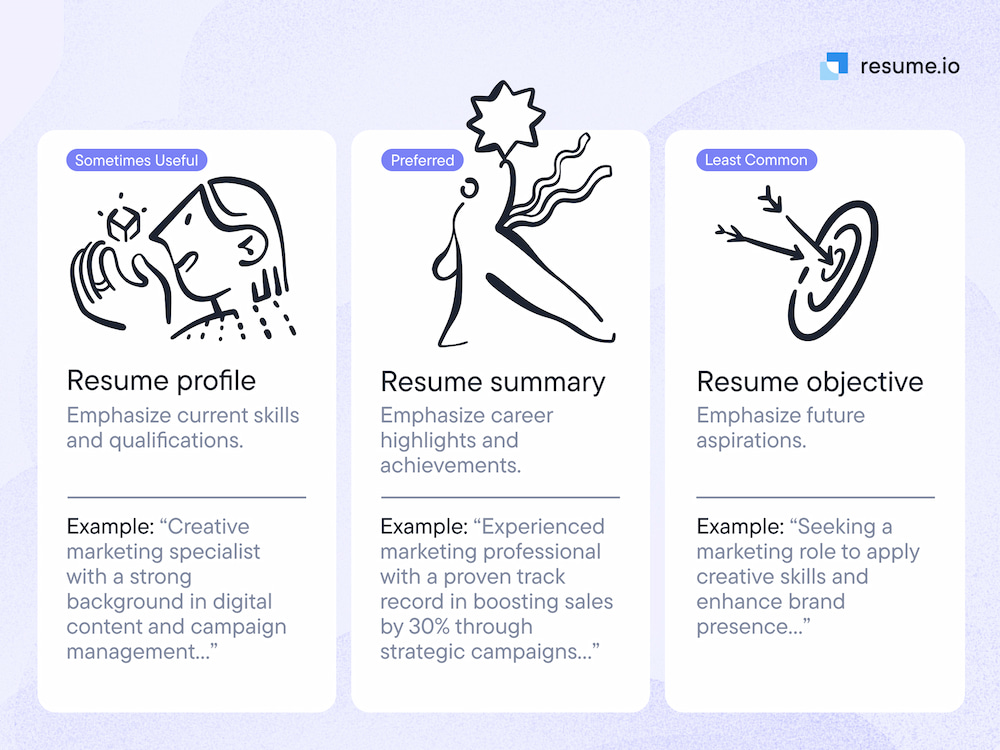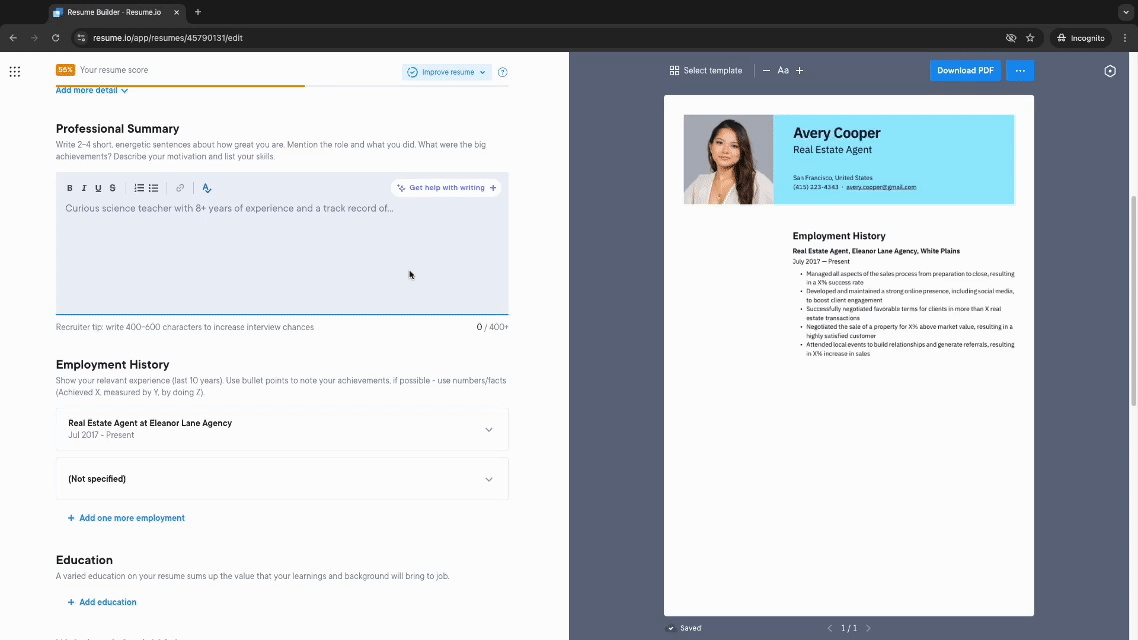The first paragraph of your resume will often determine whether a hiring manager reads the rest of your career story. There are two distinct approaches. It can be a summary of why your previous experience makes you a great fit for the role. Or it can paint a picture of your career objectives and explain how this next role will be a perfect move for you.
Both are valid approaches, and some candidates may include both in their opening sales pitch. In this blog, we aim to explore each variant to enable you to decide which is right for your situation.
- What is a resume summary?
- What is a resume objective?
- In which situations are they used?
- Examples of resume objectives and summaries
This section sets the tone, offering a snapshot of the candidate's capabilities and aspirations, enticing recruiters to delve deeper into the resume. Both elements, when crafted with precision, can significantly enhance a candidate's appeal by succinctly showcasing their value proposition to prospective employers.

What is a resume summary?

A resume summary is a concise section located at the top of your resume, designed to quickly capture an employer's attention by summarizing your most relevant qualifications, skills, and experiences. It acts as a professional snapshot, showcasing your career highlights and unique value proposition in a few impactful sentences.
Tailored to the specific job, a well-crafted resume summary emphasizes how your background aligns with the role's requirements and the employer's needs. This personalized introduction sets the tone for your resume, enticing hiring managers to delve deeper into your accomplishments and consider you as a prime candidate for the position.
When is a resume summary used?
If you are applying for a role that is a natural progression from your previous experience, a resume summary is a perfect way of beginning your sales pitch. What you have done in the past will translate directly to inform the hiring manager of your future potential.
Resume summary benefits
There are plenty of reasons why you should spend a significant amount of time crafting the perfect resume summary. And don’t forget that this should be tailored for each role. If the hiring manager feels that you are not writing specifically for them, they will move to a candidate who writes like this is the only job for them. The benefits of a resume summary include:
- Provides a concise overview of your professional background
- Highlights your most significant achievements and skills
- Sets the tone for your resume by showcasing your personal brand
- Differentiates you from other candidates
- Includes keywords relevant to the job, enhancing ATS compatibility
Resume summary example
Dynamic marketing professional with over 7 years of experience in digital campaigns, brand management, and social media strategy. Track record of increasing online presence and market share (by 29%), driving customer engagement, and fostering partnerships. Skilled in analytics and trend forecasting, with a creative mindset and a commitment to continuous improvement. Passionate about leveraging data and innovative techniques to achieve business goals and exceed performance metrics.
What is a resume objective?
A resume objective is a concise statement that outlines an applicant's career goals and how they align with the prospective employer's needs. Positioned at the top of a resume, this introductory section is typically tailored to the specific job or industry, highlighting the candidate's skills, experiences, and ambitions.
It serves to capture the employer's attention, conveying the applicant's immediate value proposition and their long-term professional aspirations. Effective resume objectives are clear, compelling, and demonstrate how the applicant's objectives support the company's goals, thereby making a strong case for why they are an ideal candidate for the position.
When is a resume objective used?
Resume objectives are typically used in two situations: at the start of a career or when changing industries. The past is not always the only hint at a bright future. Sometimes the best interviews hinge on an ability to paint a picture of your potential.
Resume objective benefits
A resume summary won’t be effective if your previous experience is either lacking or is not a fit with your future career aspirations. The resume objective is useful because it bridges the gap between past and present, uncovering your motivations and connecting the hiring manager to the version of you that they would see in the future. Benefits of a resume objective include:
- Clarifies career goals, guiding employers through your aspirations
- Tailors your application, customizing for the specific job or industry
- Grabs attention quickly, making a strong first impression
- Emphasizes transferable skills for the role
- Bridges experience gaps, focusing on your potential and future contribution
- Demonstrates enthusiasm and commitment, showcasing your genuine interest
- Facilitates career transitions, explaining shifts in industry or role
Resume objective example
Keen to transition from finance to retail management, I bring a strong background in strategic planning, budget management, and customer relations. Leveraging these skills, I aim to drive sales growth, enhance team productivity, and elevate customer satisfaction in a dynamic retail environment. My goal is to combine my analytical acumen and passion for customer engagement to become a leader in retail operations, fostering an innovative and customer-centric shopping experience.
Mistakes to avoid with a resume summary or resume objective
When crafting a resume summary or objective, it's crucial to avoid generic and overly broad statements. These can fail to capture the unique value you bring to a potential employer, making your application blend in. Instead, tailor your summary or objective to the specific job and company, highlighting relevant skills, experiences, and achievements that align with the role's requirements. This customization demonstrates a genuine interest in the position and an understanding of how you can contribute.
Resist the temptation to include irrelevant details in your summary or objective. Every piece of information should serve the purpose of illustrating your suitability for the role. Including unrelated hobbies, personal anecdotes, or skills not pertinent to the job can dilute the impact of your key qualifications. Stay focused on what's most relevant to the job description, ensuring that every word in your summary or objective contributes to an image of you as the ideal candidate for the position.
Key takeaways
- Make a summary or objective exclusively about the job in question.
- Don’t be modest here. They will expect you to try to impress them.
- In either a summary or objective, write 4-5 lines but be careful to stick to your best bits.
- Only include figures and growth percentages if they are truly impressive.





